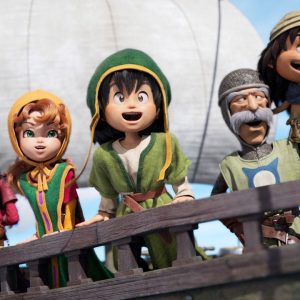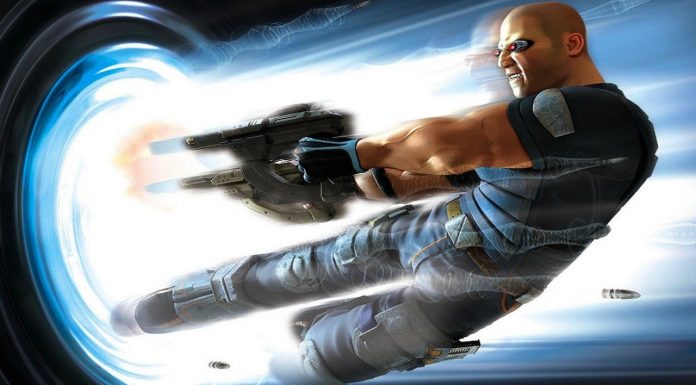And why he’s fighting with his publisher about holding players’ hands… in a game about holding hands.
Wattam, the latest project from Katamari Damacy and Noby Noby Boy designer Keita Takahashi, has been a long time coming. Many many years at this point. In that time, it’s shifted publishers from Sony to Annapurna Interactive, its team has been broken down and then rebuilt and it’s switched game engines, but one thing hasn’t changed – it’s still a game about creating colourful explosions that send its bizarre cast of anthropomorphic creatures into gales of laughter.
Of course, I wouldn’t dare call them “creatures” in front of Takahashi. To him, they may be walking, talking flowers, rocks, toilets, poos and blocks of land, but they’re all “people”. Wattam, after all, is a metaphor for the way that people from different countries can find commonalities. We may not all speak the same language, or have a similar culture, but there are things that can bring us together as people. And in the case of Wattam, as mentioned, it’s setting off the bomb that perpetually sits under the hat of the game’s Mayor character.
This idea that everything is a person is a really fun conceit. At the start of the game (which I played at this year’s BitSummit), for instance, the Mayor’s initial loneliness soon gives way to astonishment and joy when he discovers that the rocks atop his seemingly deserted block of land are, in fact, people, and that, when night gives way to day, the sun emerges, a big grin on its face. That then allows seeds to blossom into flowers, which are also – of course – people.
“
From the beginning, I thought I should make a game between Noby Noby Boy and Katamari…
For Takahashi, however, he initially wanted to take this concept and give it a Katamari-esque spin. “The original idea was more free,” he tells me, “but then we had to cut some elements, because with this small team, we thought, no, we couldn’t finish this game with this. So we cut some specific fundamental idea, but that’s okay.” And what was that big concept? Well, there was a shift in scale that went beyond the idea that there were small people atop medium-sized people. There were also large people, and “you can select everyone,” he says. “All people are controllable, so even, like, for example, Japan. Japan is also people, so Japan can move around, walk around, then there’s the United States people, and then the whole world has small people on them, and the camera zoomed in, then they can play like that.”
In other words you’d be able to zoom all the way from the macro to the micro scale, and each scale would be actively playable. “But that was super tough,” Takahashi admits. “Then also, they are standing on the sphere, [and] that made the game be more difficult to get stable, so we decided to make the ground be flat. Then, unfortunately, the world people should be not able to move around. They’re fixed, they are static, but still, you can select them then control [them], but [it’s] just tilting… Everything is still people and selectable and controllable. That idea still arrived, but the movable world person is dead. That’s sad, but I think Wattam is still a good game without that idea.”
A big picture concept like that definitely runs the risk of being more trouble than it’s worth, and ultimately a distraction from the core concept of the game which is experimentation and discovery. Indeed, like Noby Noby Boy before it, Wattam definitely has a sandbox feel, but Takahashi tells me that he’s actually going for something more structured. “From the beginning,” he says, “I thought I should make a game between Noby Noby Boy and Katamari, like a sandbox but it has a specific story, like a narrative, story-driven game and specific goal, but has a sandbox element – free feeling, but specific path, so I would say it’s a middle point.”
Despite this, he still doesn’t want the game to hold players’ hands. He wants players to be the ones doing the hand-holding in the game. In Wattam, grabbing hold of other peoples’ hands is a central mechanic, allowing you to lead them places and create chains of people. You can also switch characters at will, creating stacks – one on top of the other – or testing out their unique abilities and discovering how they interact with others.
His freeform vision isn’t necessarily what his new publisher wants, however. “Annapurna people told me ‘we need to show a specific goal for the player, or the player will not know, how can we solve this issue,’ but that’s a puzzle – that’s the game,” he laments. “If we show more hints, that’s not going to be that game. But it sounds like these days the players are spoiled, like a mobile game is very gentle and kind, they teach everything: ‘Press here and go there.’ And then even the triple A title games are signposted – go there and pick something [up]. All the time you can see your goal or purpose. That is a point we fight [about].”
“
It sounds like these days the players are spoiled…
The resolution, Takahashi says, is that he and Annapurna “just find a middle point… show some hint but not so many.” I’m hoping that this middle point lands on the side of less player direction, as hints in freeform games often wind up feeling like a mollycoddling parent, eager to ensure you don’t miss the thing, and failing to understand that you’re off mucking around with something else entirely and aren’t even interested in what the next step to progress might be.
However it winds up working out, I’d also like to think the tension between Takahashi and Annapurna will result in a stronger game. Takahashi, after all, seems to enjoy being a video game outsider. “I usually don’t play video games,” he says at one point in reference to advice his publisher provided, and later, when I ask whether fatherhood has changed how he sees games: “Video games are so boring, not exciting.” This is a common refrain from Takahashi. Hell, he was disappointed by Super Mario Odyssey and Breath of the Wild. He’s an outsider auteur, effectively, and thus, his team and his publisher will have some pretty valuable alternative perspectives.
Wattam’s sandbox sensibilities are corralled into a path for players that takes them through different worlds represented by different seasons. “That’s linear,” Takahashi tells me. “Unfortunately that’s linear. But there’s still enough space to play freely.” Four very different playgrounds, then, tied together by some kind of narrative, all culminating – one presumes – in a definitive ending.
How the gameplay will evolve over that time remains to be seen, but there’ll likely be more and more interactions to discover and mini puzzles to solve, as Takahashi teases that you can transport all the people that have come to your world with you to the next one. “And then the people who live on the different world speak a different language, like us. So they can’t understand each other.” How to communicate? “Just by explosion!” he exclaims, before laughing just as the characters in the game do each time the bomb goes off. It’s absurd, playful and thoroughly Seussian, which makes me love it all the more.
Wattam will be a social experience for those that want it to be too, with co-op available throughout the whole game. “I think that’s the best way to play Wattam,” Takahashi says. “Friend with friend, talk while playing – ‘hey, let’s go do that!’ I think that’s a great opportunity.”
Wattam, which should be out this year (although that was also the case last year) isn’t the only project Takahashi is working on right now. I ask about Crankin’s Time Travel Adventure, the game he’s making for the new Playdate handheld system, and he pulls a dev kit out of his bag and hands it over for me to try out.
The game, like the system, is adorable; the crank on the side is used to move time forwards or wind it backwards, and each level sees the tin man protagonist Crankin’ trying to get to a date with his girlfriend. Early obstacles are simple: you stop to sniff a flower on your way, then encounter a (level ending) butterfly, so have to rewind back so it can pass safely overhead while you’re leaning down to smell the flower. The black and white line drawing presentation is charming, the animations wonderfully bouncy, and the sproingy sound effects perfect.
It’s cool to see what Takahashi does when he has more restrictions. This is easily his most straightforward game to date; a 2D puzzle-platformer in which he has honed in on the crank and designed his game entirely around it. With a goal of 50 dates, Takahashi has plenty of scope to riff on the core concept and to upend expectations, but, much like Wattam, exactly how that will manifest itself remains to be seen. Here’s hoping there isn’t long until we find out.
Cam Shea is Editor in Chief for IGN’s Australian content team and loves quirky Japanese games. He’s on Twitter.

























